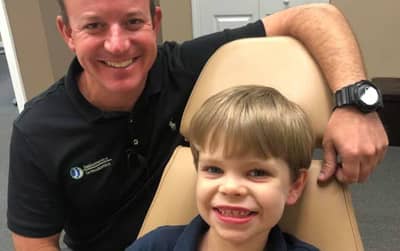Children are receiving orthodontic care at younger ages than ever before. Although past practices dictated that orthodontic treatment held no significant benefits until permanent teeth were present, this has proven to be incorrect. Children can experience better overall results when orthodontic intervention occurs at a younger age.
2 Phase Process
This treatment model normally consists of two separate times that a child receives orthodontic care. The first time occurs when the child still has their primary or “baby” teeth. The second treatment phase occurs after the child has lost their primary teeth and has most of their permanent teeth. The two phase process allows orthodontists to take advantage of a child’s natural growth process to increase the benefits of treatment.
Goals of Phase 1
 A child is often referred to an orthodontist because a dentist observes problems, or potential problems in the teeth or jaw alignment of a child. Given the child’s young age and expected growth, Phase 1 goals include:
A child is often referred to an orthodontist because a dentist observes problems, or potential problems in the teeth or jaw alignment of a child. Given the child’s young age and expected growth, Phase 1 goals include:
- Prevent a problem from developing (preventative treatment)
- Intercept a developing problem (interceptive care)
- Guide the growth of the jawbone that support the teeth (growth modification treatment)
The objective is to avoid an unhealthy environment for the development of teeth, gums, jaws, and face development. Early intervention at this time can avoid or reduce the severity of bite problems, teeth mis-alignment, misaligned upper and lower jaws, and more.
Phase 1 intervention may contribute to the long-term stability of the process since changes made at younger ages are more likely to become permanent. Early intervention will instill healthy dental habits and often produce the greatest benefits since children at this age are often more compliant to instructions.
Goals of Phase 2
Once the majority of the child’s permanent teeth are present, the orthodontist will use braces and other appliances to move the child’s teeth into their final positions. Retainers are used to preserve the results achieved through orthodontic intervention.
Importance of the 2 Phase Process
Seeking early treatment for existing or potential jaw, teeth, and bite problems can help reduce or eliminate the severity of these issues as a child grows and matures. It can also reduce the risk of breakage of protruding teeth and can improve a child’s self-esteem. If treatment is delayed, the process can take longer and require more intensive treatment, including surgery.
The ultimate goals are for a child to have a healthy mouth, beautiful smile and an attractive face and profile. A 2 Phase treatment process is often the best, least invasive way to achieve those goals.

















